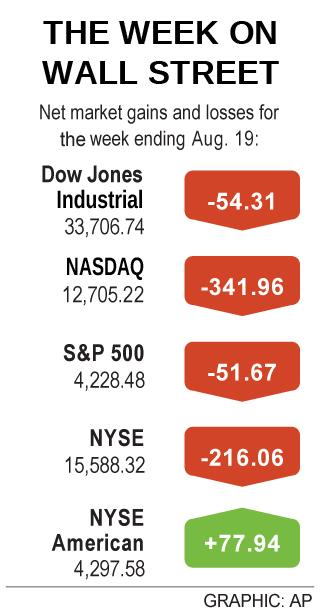US stocks on Friday fell in a broad sell-off led by megacaps as US bond yields rose, with the S&P 500 posting losses for the week after four straight weeks of gains.
Amazon.com Inc, Apple Inc and Microsoft Corp all fell and were the biggest drags on the S&P 500 and NASDAQ. Higher rates tend to be a negative for technology and growth stocks, the valuations of which rely more heavily on future cash flows.
US Treasury yields rose, with the benchmark 10-year note nearly hitting 3 percent, after Germany reported record-high increases in monthly producer prices.

Investors have been weighing how aggressive the US Federal Reserve might need to be as it raises interest rates to battle inflation.
Federal Reserve Bank of Richmond President Thomas Barkin said on Friday that US central bank officials have “a lot of time still” before they need to decide how large an interest rate increase to approve at their Sept. 20-21 policy meeting.
“The rise in rates around the globe and tough talk from central bankers are being used as an excuse to push stocks lower in very light volume on an August Friday session,” said Peter Cardillo, chief market economist at Spartan Capital Securities in New York.

Photo: AFP
The Dow Jones Industrial Average fell 292.3 points, or 0.86 percent, to 33,706.74; the S&P 500 lost 55.26 points, or 1.29 percent, to 4,228.48; and the NASDAQ Composite dropped 260.13 points, or 2.01 percent, to 12,705.22.
All three major indices registered losses for the week. The S&P 500 fell about 1.21 percent and the NASDAQ slid 2.62 percent in their first weekly declines after four weeks of gains. The Dow lost 0.16 percent for the week.
After notching its worst first half since 1970, the S&P 500 has bounced about 16 percent from its mid-June low, fueled by stronger-than-expected corporate earnings and hopes the economy can avoid a recession even as the Fed hikes rates.
Friday’s monthly options expiration should also make way for greater near-term stock market moves as options positions expire, said Brent Kochuba, founder of options-focused financial insights company SpotGamma.
The US central bank needs to keep raising borrowing costs to tame decades-high inflation, a string of US central bank officials said on Thursday, even as they debated how fast and how high to lift them.
The Fed has raised its benchmark overnight interest rate by 225 basis points since March to fight inflation at a four decade-high.
Focus this week might be on Fed Chairman Jerome Powell’s speech on the economic outlook at the annual global central bankers’ conference in Jackson Hole, Wyoming.
“Meme stock” Bed Bath & Beyond Inc plunged 40.5 percent as billionaire investor Ryan Cohen exited the struggling home goods retailer by selling his stake.
Shares of Deere & Co ended slightly higher, even after it lowered its full-year profit outlook and said it has sold out of large tractors as it grapples with parts shortages and high costs.
Volume on US exchanges was last at 10.01 billion shares in one of the lowest volume days of the year.
Declining issues outnumbered advancing ones on the New York Stock Exchange by a 6.06-to-1 ratio; on NASDAQ, a 3.59-to-1 ratio favored decliners.
The S&P 500 posted one new 52-week high and 29 new lows; the NASDAQ Composite recorded 43 new highs and 93 new lows.

The US dollar was trading at NT$29.7 at 10am today on the Taipei Foreign Exchange, as the New Taiwan dollar gained NT$1.364 from the previous close last week. The NT dollar continued to rise today, after surging 3.07 percent on Friday. After opening at NT$30.91, the NT dollar gained more than NT$1 in just 15 minutes, briefly passing the NT$30 mark. Before the US Department of the Treasury's semi-annual currency report came out, expectations that the NT dollar would keep rising were already building. The NT dollar on Friday closed at NT$31.064, up by NT$0.953 — a 3.07 percent single-day gain. Today,

‘SHORT TERM’: The local currency would likely remain strong in the near term, driven by anticipated US trade pressure, capital inflows and expectations of a US Fed rate cut The US dollar is expected to fall below NT$30 in the near term, as traders anticipate increased pressure from Washington for Taiwan to allow the New Taiwan dollar to appreciate, Cathay United Bank (國泰世華銀行) chief economist Lin Chi-chao (林啟超) said. Following a sharp drop in the greenback against the NT dollar on Friday, Lin told the Central News Agency that the local currency is likely to remain strong in the short term, driven in part by market psychology surrounding anticipated US policy pressure. On Friday, the US dollar fell NT$0.953, or 3.07 percent, closing at NT$31.064 — its lowest level since Jan.

The New Taiwan dollar and Taiwanese stocks surged on signs that trade tensions between the world’s top two economies might start easing and as US tech earnings boosted the outlook of the nation’s semiconductor exports. The NT dollar strengthened as much as 3.8 percent versus the US dollar to 30.815, the biggest intraday gain since January 2011, closing at NT$31.064. The benchmark TAIEX jumped 2.73 percent to outperform the region’s equity gauges. Outlook for global trade improved after China said it is assessing possible trade talks with the US, providing a boost for the nation’s currency and shares. As the NT dollar

The Financial Supervisory Commission (FSC) yesterday met with some of the nation’s largest insurance companies as a skyrocketing New Taiwan dollar piles pressure on their hundreds of billions of dollars in US bond investments. The commission has asked some life insurance firms, among the biggest Asian holders of US debt, to discuss how the rapidly strengthening NT dollar has impacted their operations, people familiar with the matter said. The meeting took place as the NT dollar jumped as much as 5 percent yesterday, its biggest intraday gain in more than three decades. The local currency surged as exporters rushed to